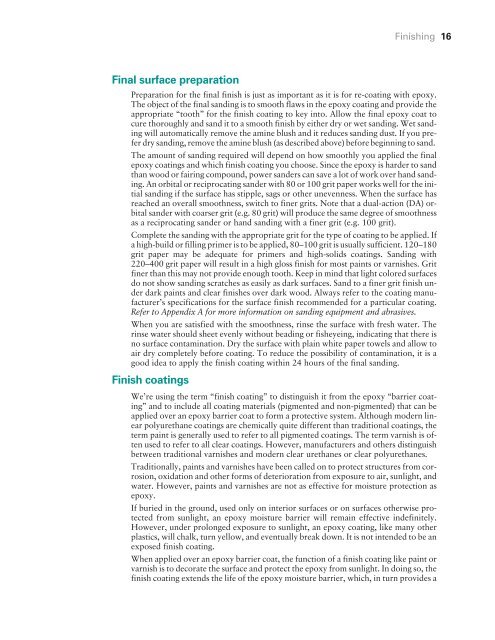Final Fairing & Finishing - WEST SYSTEM Epoxy
Final Fairing & Finishing - WEST SYSTEM Epoxy
Final Fairing & Finishing - WEST SYSTEM Epoxy
You also want an ePaper? Increase the reach of your titles
YUMPU automatically turns print PDFs into web optimized ePapers that Google loves.
<strong>Final</strong> surface preparation<br />
Preparation for the final finish is just as important as it is for re-coating with epoxy.<br />
The object of the final sanding is to smooth flaws in the epoxy coating and provide the<br />
appropriate “tooth” for the finish coating to key into. Allow the final epoxy coat to<br />
cure thoroughly and sand it to a smooth finish by either dry or wet sanding. Wet sanding<br />
will automatically remove the amine blush and it reduces sanding dust. If you prefer<br />
dry sanding, remove the amine blush (as described above) before beginning to sand.<br />
The amount of sanding required will depend on how smoothly you applied the final<br />
epoxy coatings and which finish coating you choose. Since the epoxy is harder to sand<br />
than wood or fairing compound, power sanders can save a lot of work over hand sanding.<br />
An orbital or reciprocating sander with 80 or 100 grit paper works well for the initial<br />
sanding if the surface has stipple, sags or other unevenness. When the surface has<br />
reached an overall smoothness, switch to finer grits. Note that a dual-action (DA) orbital<br />
sander with coarser grit (e.g. 80 grit) will produce the same degree of smoothness<br />
as a reciprocating sander or hand sanding with a finer grit (e.g. 100 grit).<br />
Complete the sanding with the appropriate grit for the type of coating to be applied. If<br />
a high-build or filling primer is to be applied, 80–100 grit is usually sufficient. 120–180<br />
grit paper may be adequate for primers and high-solids coatings. Sanding with<br />
220–400 grit paper will result in a high gloss finish for most paints or varnishes. Grit<br />
finer than this may not provide enough tooth. Keep in mind that light colored surfaces<br />
do not show sanding scratches as easily as dark surfaces. Sand to a finer grit finish under<br />
dark paints and clear finishes over dark wood. Always refer to the coating manufacturer’s<br />
specifications for the surface finish recommended for a particular coating.<br />
Refer to Appendix A for more information on sanding equipment and abrasives.<br />
When you are satisfied with the smoothness, rinse the surface with fresh water. The<br />
rinse water should sheet evenly without beading or fisheyeing, indicating that there is<br />
no surface contamination. Dry the surface with plain white paper towels and allow to<br />
air dry completely before coating. To reduce the possibility of contamination, it is a<br />
good idea to apply the finish coating within 24 hours of the final sanding.<br />
Finish coatings<br />
<strong>Finishing</strong> 16<br />
We’re using the term “finish coating” to distinguish it from the epoxy “barrier coating”<br />
and to include all coating materials (pigmented and non-pigmented) that can be<br />
applied over an epoxy barrier coat to form a protective system. Although modern linear<br />
polyurethane coatings are chemically quite different than traditional coatings, the<br />
term paint is generally used to refer to all pigmented coatings. The term varnish is often<br />
used to refer to all clear coatings. However, manufacturers and others distinguish<br />
between traditional varnishes and modern clear urethanes or clear polyurethanes.<br />
Traditionally, paints and varnishes have been called on to protect structures from corrosion,<br />
oxidation and other forms of deterioration from exposure to air, sunlight, and<br />
water. However, paints and varnishes are not as effective for moisture protection as<br />
epoxy.<br />
If buried in the ground, used only on interior surfaces or on surfaces otherwise protected<br />
from sunlight, an epoxy moisture barrier will remain effective indefinitely.<br />
However, under prolonged exposure to sunlight, an epoxy coating, like many other<br />
plastics, will chalk, turn yellow, and eventually break down. It is not intended to be an<br />
exposed finish coating.<br />
When applied over an epoxy barrier coat, the function of a finish coating like paint or<br />
varnish is to decorate the surface and protect the epoxy from sunlight. In doing so, the<br />
finish coating extends the life of the epoxy moisture barrier, which, in turn provides a
















